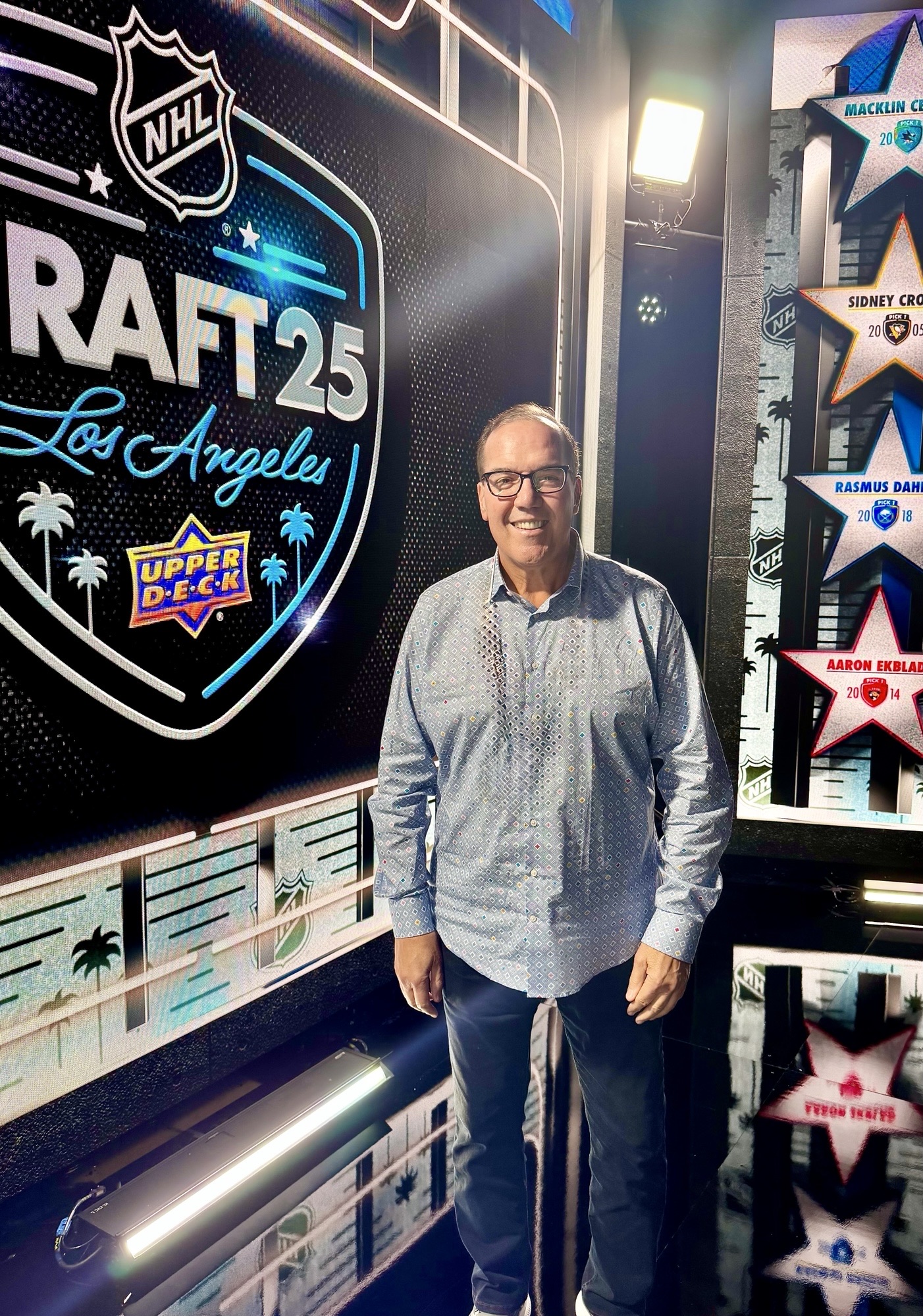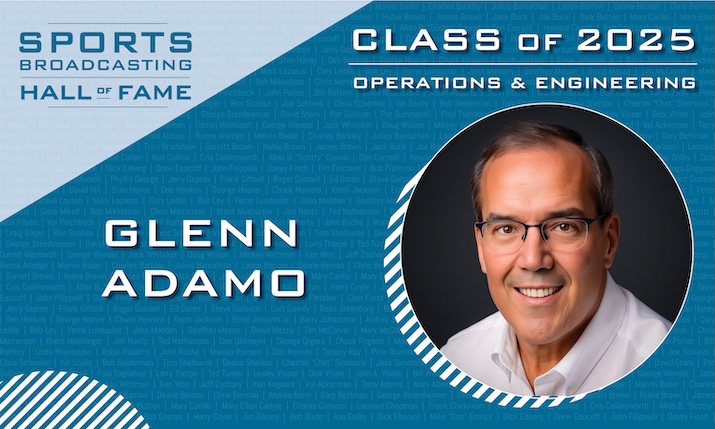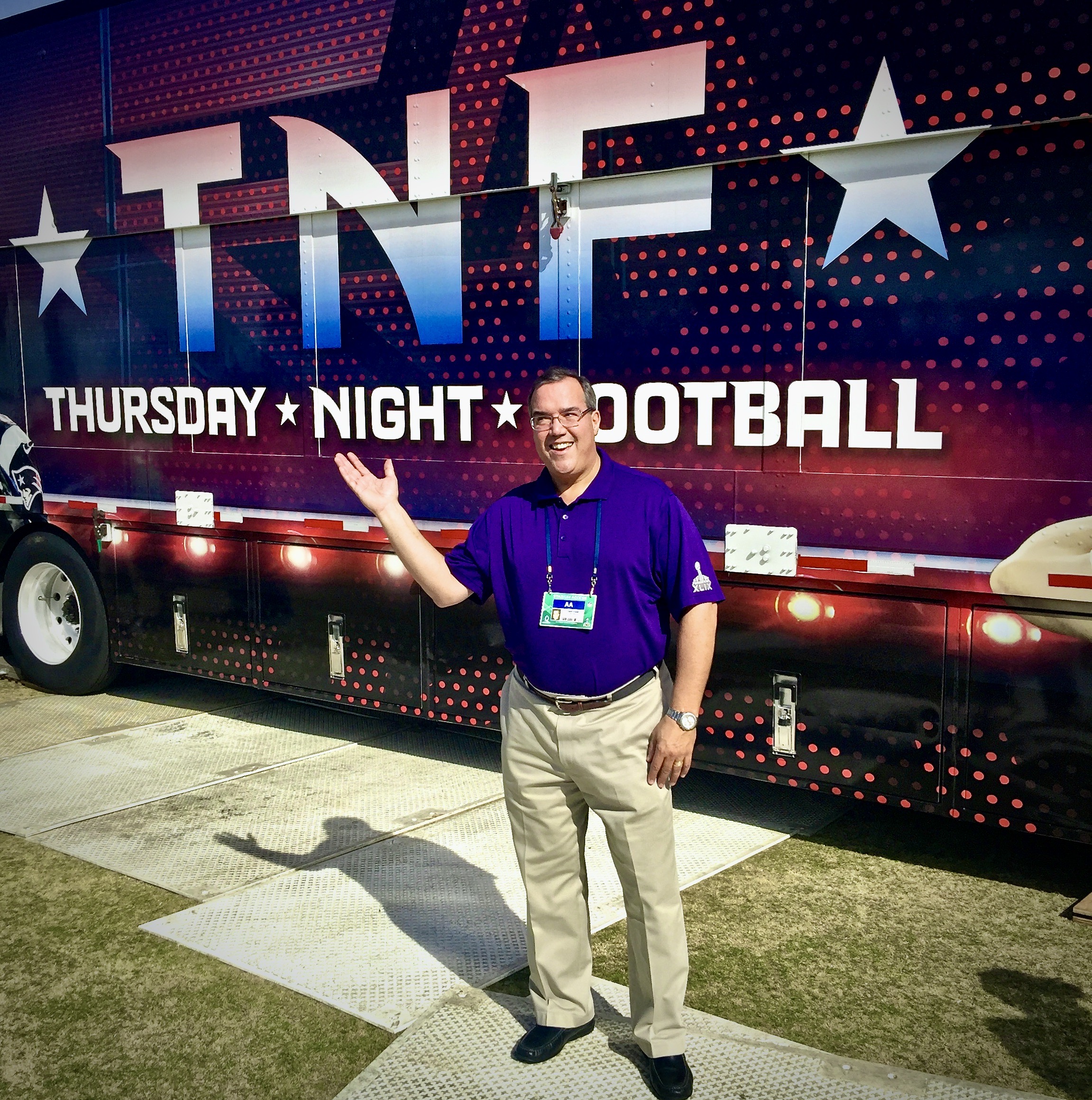2025 Sports Broadcasting Hall of Fame: Glenn Adamo, Artist of Storytelling
Story Highlights
Glenn Adamo may have begun his career in sports on the ice, but his impact on the industry has been in the production truck and the front office. Whether it was at NBC Sports, the NHL, the NFL, the New Jersey Devils, or The Switch, he proved adept and creative when it came to storytelling, operations, and technology.
Adamo’s approach to deploying new technology — whether getting cameras in the goal or red lights in the penalty box to denote TV timeouts — was to make sure it made sense for the production team, the viewer at home, and even the athletes.
“How can it make the show more enjoyable for the fan back home?” he says. “When we first put a Fletcher HD camera in the goal and Detroit’s Steve Yzerman scored on a slap shot, we knew we had struck gold with that camera, and our thought process for coverage changed.”
Adamo’s career in sports production began when a knee operation in college forced him to give up on the dream of becoming an NHL player (he had been offered a tryout at the St. Louis Blues following a college career at the University of Connecticut). But things have worked out just fine for him, and, in 40+ years, he has had an indelible impact as both producer and front-office executive.
From the Ice to the Peacock
A Brooklyn native, Adamo grew up among hockey royalty, playing with future NHL player Bob Francis (Adamo’s best man and godfather to his son) and Hall of Famer Joe Mullen, and he credits Francis’s NHL Hall of Famer father, Emile, as one of the most influential people in his life. Adamo went on to play hockey at UConn but opted not to pursue a pro career because of a series of knee injuries. His mother worked at NYU and made him aware of a summer program at New York University’s Film and Television school.

Adamo on his introduction to broadcasting via an NYU Film and Television School summer program: “It was intense, and I fell in love with broadcasting instantly.”
“It was eight hours a day six days a week for the entire summer,” he says. “It was intense, and I fell in love with broadcasting instantly. It was a lot like being an athlete: you get immediate feedback as to whether something was good or bad.”
The bug led to his hunting opportunities, which resulted in a stint as freelance AD for WWOR-TV New York and New York Mets games, but it wasn’t until he was a summer relief switchboard operator at WNBC-TV that things began to fall into place.
“I knew Marv Albert and Dick Shapp from my days being around the New York Rangers,” he notes, “and they got me working in the studio on weekends as a ‘runner,’ doing whatever needed to be done.”
In the late ’70s, NBC Sports producer Ginny Seipt hired Adamo as a production assistant, and Executive Producer Don Ohlmeyer assigned him to the 1980 Moscow Olympics Profile Unit. After the U.S. announced that it would be boycotting the Moscow Games, Adamo became a full-time PA, working everything from Wimbledon and French Open tennis to the NFL, NBA, and Major League Baseball.
“Ginny was probably most responsible for my success,” says Adamo. “She just drilled me about mistakes and the need to pay attention to detail, being responsible, and being accountable. At that time, I would just observe, watch, and learn the vibe of the business,” he adds of his formative professional years. “By watching, you learn what works and what doesn’t work and also what works and doesn’t work for you.”
Just before leaving NBC in 1982, Ohlmeyer elevated Adamo to associate producer, and, in 1984, new chief (and close friend) Michael Weisman offered Adamo his first producer contract. Adamo also served as coordinating videotape producer for the 1988 Seoul Olympics.
“Mike was one of the first people to tell me I was really creative,” recalls Adamo. “I would come up with crazy ideas that someone would like. I approached Dick Enberg once and said, Why don’t we do a feature that wraps up Wimbledon, and ‘Dick Enberg’s Memories’ was born. Dick loved the idea, and we would edit it for 18 hours and then take a half-hour nap and do a full day for the men’s final.”
In 1988, Dick Ebersol arrived at NBC and elevated Adamo to coordinating producer on a variety of shows, including Sportsworld, Wimbledon and French Open tennis, and anthology programming. He also worked extensively on the 1992 Barcelona Olympics and, that year, had one of his career highlights.
“Ebersol said he had someone special who wanted to come into the truck at Wimbledon and wanted to see Dick’s Memories,” Adamo recalls. “He brings in Johnny Carson, who says Dick’s Memories was his favorite part of Wimbledon. We played about 14 minutes of it for him, and he turned to me, put out his hand, and said, ‘Young man, that’s not television. That’s art.’ When he left, I bolted, called my wife, and said, ‘Johnny Carson just told me what I produce is art!’”
As much as there is art in sports production, there are also business, personalities, and the need for the next thing. In 1993, Ebersol provided the gateway for Adamo’s next big break.
“Dick Ebersol called me into his office one day and told me that Gary Bettman, whom I knew from working the NBA on NBC, was going to be the commissioner of the NHL,” recounts Adamo. “[Ebersol] knew how much I loved hockey and said Gary was looking for someone to start and run his broadcast department. I met with Gary, and we hit it off immediately, so I took the job. It was magic right from the start at [the NHL], and I learned more there than anywhere in my career.”
A Return to the Rink — in the Front Office
Bettman’s and Adamo’s arrival at the NHL dropped the puck on a league media revolution that lifted TV ratings and increased the league’s popularity in the U.S.
“I was a sponge with Gary,” says Adamo. “He said he would teach me the business of sports. He was a taskmaster but in a great way.”

Adamo was with the New Jersey Devils when they won the Stanley Cup in 2003: “It was a life-long dream come true.”
As VP of broadcasting at the NHL, Adamo instituted a commercial-timeouts format that boosted advertising revenue; revamped the league’s scheduling practices to allow 100-plus televised games per season in both the U.S. and Canada; and introduced an arsenal of production elements, including cameras in the goal nets and mics on the players, benches, and arena perimeter.
“[Bettman] gave me freedom because of my production background,” says Adamo. “I made a bunch of changes to the game, which he supported. We changed the way the game was covered and changed the TV-commercial policy to allow more storytelling about the players and the game. My background, because of my time working for Ebersol, was as a storyteller, so that’s what came first.”
In addition, he launched NHL Productions, which turned into a multimillion-dollar business within three years, producing a wealth of NHL content and signing a profitable home-video deal.
“We had a blank slate, and Gary gave us free rein,” says Adamo. “He was very involved and steered us in the right direction but never micromanaged.”
He says Bettman and Ebersol were two of the most influential people in his professional life. “Bettman is the best boss I ever had and the smartest guy I’ve ever met, a true mentor. He had the same knowledge and passion for the game that I had, and that is why the two of us clicked together.”
Adamo’s subsequent journey took him to other organizations, but, following the pandemic, he began working with the NHL again on content strategy. “We’re working on what the next generation of NHL Media is going to look like,” he explains. “I’m just thrilled to be able to work with the NHL again.”
The (New Jersey) Devil Inside
Having always dreamed of winning a Stanley Cup, Adamo saw his opportunity in 2001 when longtime New Jersey Devils President/CEO/GM Lou Lamoriello came calling. “After trying for years to get me to work with him at the Devils, Lou finally convinced me to come aboard [in 2001],” Adamo says. “When we got that Stanley Cup ring in 2003, it was a life-long dream come true.”
With the Devils, he oversaw all in-house entertainment, the team’s relationships with TV and radio rightsholders, and community development.
NFL Network on the Rise
The Devils took down the Anaheim Ducks in 2003 to win Lord Stanley’s Cup, and, with a Stanley Cup ring checked off his bucket list, Adamo was ready for a new challenge.
“I got very lucky,” he says. “[then–NFL Media CEO/Network President] Steve Bornstein, who is a genuine icon in our business and a guy I always wanted to work with, called me and said he was starting up a network. He asked me, with my broadcast and scheduling background, would I want to come over and get involved. I came on board about two months before we launched and hit the ground at 90 mph.”
He recalls that former NFL Commissioner Paul Tagliabue, who remembered him from his days at NBC, was very kind and set Adamo up in the office of NFL legend and Sports Broadcasting Hall of Famer Val Pinchback. “He put me in the corner office where Val used to sit,” Adamo says. “I loved being there and being able to work with Steve, who was wonderful with me.”
Joining the NFL in 2003, Adamo played an integral role in NFL Network’s launch and the construction of its studio in Culver City, CA, as well as developing the Thursday Night Football package. He also spearheaded development of the league’s successful flexible scheduling system, which was implemented in 2006 and allows the league to move marquee matchups to NBC’s Sunday Night Football without damaging the Sunday-afternoon offerings on CBS and FOX. He also oversaw day-to-day operations for the league’s vast media portfolio (NFL Films, NFL Network, DIRECTV’s NFL Sunday Ticket), and helped the operation leap from SD to HD.
“The NFL Network was SD, and it looked just awful,” says Adamo. “I wanted to go HD and put together a plan for Steve. The first proposal had a cost of around $10 million. I managed to get it down to $7 million, and Steve said go ahead. When we went HD, [NFL Commissioner] Roger Goodell wrote a text to Steve says what a difference it made.”
Family and the Future
Today, Adamo is based in New Jersey, carving out quality time for Valerie, his wife of 47 years, and children Gregory, 40, and Marissa, 36. Oh, and there are four grandchildren to entertain.

Adamo: “My goal is to do this as long as I can, because it continues to be challenging and is a lot of fun.”
“[Family] is extremely important to me,” he says. “I’m blessed because I married my best friend. In our business, where there are a lot of casualties, that is pretty rare.”
Still a hockey nut at heart, Adamo is former owner of a twin ice-hockey rink and a current New York Rangers season-ticket holder.
“When I can get away from the day-to-day and get on the ice and skate with my son and kids I used to coach, it’s so fulfilling,” he says. “Around the holidays, we close the rink down, and my family, including our four grandkids, skate for a few hours and have the time of our life.”
As for the future, Adamo has no plans to slow down anytime soon. Like many executives in the business, he sees a golden opportunity in the recent proliferation of digital and broadband platforms — both in the home and on the go.
“This is a business where, due to the ever-changing technology, you want to be part of it and work forever,” he says. “When people ask me when I want to retire, I say, ‘Maybe at 90.’ My goal is to do this as long as I can, because it continues to be challenging and is a lot of fun.”



